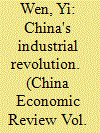| Srl | Item |
| 1 |
ID:
182811


|
|
|
|
|
| Summary/Abstract |
In “The Industrial Structure of Production: An Outline of a Research Program,” Ronald Coase and Ning Wang (2001) made a plea for a new economic research program that can go beyond the Arrow-Debreu framework and explain China's miraculous rise. They point out that the greatest trouble with the Arrow-Debreu framework lies in its inability to explain production. In this article I will push this insight further to shed new light on why and how production, or mass production in particular, emerged and mushroomed in the 18th–19th century England, the 19th–20th century United States, and 20th-21st century China but not in other parts of the world with similar geo-developmental conditions such as the Netherlands, Mexico, or India. My central thesis is that production or firms emerge in response to market demand, yet the so-called “market” is itself a fundamental public good that must be created by a development state instead of the “invisible hand.” Therefore, the lack of industrialization in any nation seems on the surface due to the lack of mass supply, but is in fact due to the lack of a mass market, which in turn is due to the lack of powerful and strong-willed market creators.
|
|
|
|
|
|
|
|
|
|
|
|
|
|
|
|
| 2 |
ID:
112719


|
|
|
|
|
| Publication |
2012.
|
| Summary/Abstract |
China's over 25% aggregate household saving rate is one of the highest in the world. One popular view attributes the high saving rate to fast-rising housing prices in China. However, cross-sectional data do not show a significant relationship between housing prices and household saving rates. This article uses a simple consumption-saving model to explain why rising housing prices per se cannot explain China's high household saving rate. Although borrowing constraints and demographic changes can translate housing prices to the aggregate saving rate, quantitative simulations of our model using Chinese time-series data on household income, housing prices, and demographics indicate that rising mortgage costs can increase the aggregate saving rate by at most 2 to 4 percentage points in the best down-payment structure.
|
|
|
|
|
|
|
|
|
|
|
|
|
|
|
|